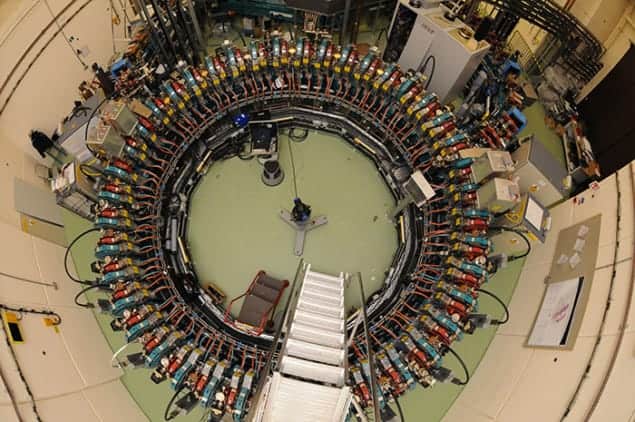
Smaller, potentially cheaper sources of high-intensity protons could become reality thanks to a novel type of fixed-field alternating-gradient (FFAG) accelerator designed by a physicist in the UK. FFAGs were first developed in the 1950s but have only recently come to the fore as a result of improved magnet and computing technology. The new design should be able to reach higher energies than existing devices and might prove well suited to transmuting radioactive waste, among other things.
Whereas particle accelerators operate at the highest possible energies to search for new particles, other machines are designed to yield very high intensities (albeit at fairly high energies). Synchrotrons, for example, use electromagnets to accelerate charged particles in a closed loop. To stop the particles drifting outwards as they speed up, these devices have magnets whose fields are ramped up in line with the particles’ increasing energy. But as the magnetic field changes with time, a synchrotron cannot simultaneously hold particles with different energies, thereby limiting its intensity.
Cyclotrons, meanwhile, do not suffer from this shortcoming, using magnets with a fixed field that allow high particle currents. Unfortunately, the particles in a cyclotron trace out ever larger orbits as they speed up, meaning that the device’s energy is limited by the strength and size of the magnets. While synchrotrons can produce beams of protons with several gigaelectronvolts or even teraelectronvolts in the case of the Large Hadron Collider at CERN, cyclotrons usually cannot manage more than a few hundred megaelectronvolts.
Best of both worlds
An FFAG, in principle, can combine the best of both worlds by using magnetic fields that vary in space rather than in time. Its magnets are designed so that their field strength increases sharply towards the edge of the machine, which keeps the orbits of faster-moving particles confined within a moderate radius. An FFAG can also operate quickly because its magnets do not have to ramp up and down. The result: beams of particles with high energies and high intensities.
Unfortunately, in practice FFAGs are hard to build. Their space-varying fields require that the accelerated particles be confined both horizontally and vertically as they travel in a circle. This can be done using two types of “radial” magnet shaped like slices of cake, which alternately focus and defocus particles in the horizontal plane while simultaneously defocusing and focusing them vertically. But the use of defocusing magnets pushes the particle orbits further out than they would otherwise be. At high energies, this would make FFAGs significantly larger, and more expensive, than synchrotrons.
An alternative option is for FFAGs to confine particles using spiral-shaped magnets. The idea here is that the bulk of each magnet focuses particles horizontally while its spiral edge defocuses them without pushing them out – and vice-versa for the vertical focusing. However, high energies require very tight spirals, which are hard to make.
Soften demands
In the latest work, Shinji Machida at the Science and Technology Facilities Council (STFC) Rutherford Appleton Laboratory near Oxford lays out the design of what he calls a DF-spiral FFAG that incorporates both radial and spiral elements. In other words, it uses focusing and defocusing magnets, both of which have a spiral shape. This allows Machida to soften the demanding requirements of machines that use just one or the other – reducing the circumference compared to a purely radial device, and the “spiral angle” compared to a purely spiral one.
In particular, he calculates that the circumference of a 1.2 GeV proton machine could be roughly halved by adding a 45° spiral to the edge of its focusing and defocusing magnets.
Roger Barlow of the University of Huddersfield in the UK describes the research as “an important development” in the quest for GeV-energy, high-intensity proton accelerators, arguing that the design “has obvious cost and space advantages”. But he says that developing suitably shaped coils to provide the magnetic fields for such a device will be challenging.
Also enthusiastic is Ken Peach of the University of Oxford, who says that the new design would require smaller and fewer magnets than “non-scaling FFAGs”, which themselves simplify magnet design by varying the field roughly linearly with radial distance. (In contrast, scaling FFAGs, including Machida’s, rely on a power-law variation.)
Potential limits
Carol Johnstone of Fermilab in the US, on the other hand, remains to be convinced. She agrees that a DF-spiral machine would be smaller than other scaling FFAGs, but says it would nonetheless remain larger than non-scaling devices. It would also be unable to generate continuous beams, she maintains, which would limit its intensity.
Machida and colleagues are currently planning a prototype high-intensity device, probably, he says, based on the DF-spiral design. Requiring prior R&D on magnets, radio-frequency systems and beam diagnostics, the idea, he says, is to show the device’s “superiority to the accelerator community in a convincing way”.
The research, currently available on arXiv, will be published in Physical Review Letters.



